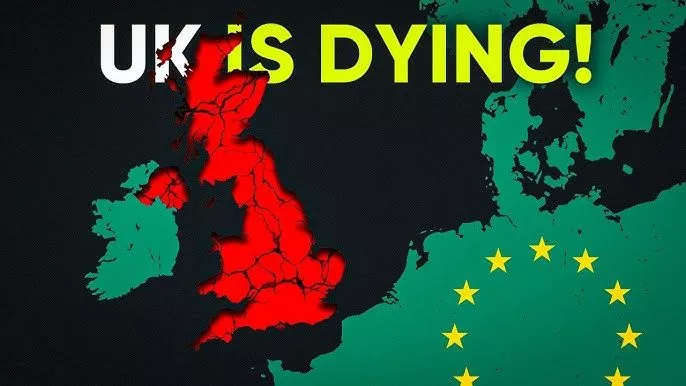
It has been five years since Brexit "got done" - and voters and politicians alike are still counting the cost.
Britons voted to leave the European Union by 52 per cent to 48 per cent in 2016, in a rare referendum that triggered the resignation of prime minister David Cameron. The United Kingdom then officially withdrew from the European Union on 31 January 2020, followed by a transition period that lasted until January 2021.
Brexiteers promised a new age of British sovereignty, a crackdown on migration and the much-derided "£350m a week" that could be diverted from the EU back into the NHS.
But half a decade on, and by many metrics, Brexit appears to have missed the mark.
The cost of Brexit is still being determined, but the government watchdog estimates that the economy will take a 15 per cent hit to trade in the long term, while experts suggest that the UK has suffered £100bn in lost output each year.
Since Britain left the EU, migration has been at the highest levels since records began; while key sectors face staffing shortages.
And almost six in 10 Britons (59 per cent) think that Brexit has gone fairly or very badly, with just 12 per cent believing it has gone well, according to a YouGov poll in October.
UK trade expert David Henig told The Independent: "The UK now has significant trade barriers to its neighbours. It's something we will have to live with. We will not be allowed to forget it; there will always be issues."
Brexit-optimist economist Julian Jessop, a fellow at the Institute of Economic Affairs, admitted that Brexit has made it harder or "impossible" for small businesses to adjust.
"The UK's departure from the EU has undoubtedly had some negative effects on the economy, notably through reductions in trade, shortfalls in business investment, and disruption to labour markets," he told The Independent.
However, he added that the "overall drag on exports and imports has been much smaller than feared".
Former deputy prime minister Lord Heseltine said that nearly five years on, Brexit "has been a historic disaster".
"It has destroyed Britain's leadership in Europe just at a time when there was a critical need (for it), it has closed off opportunities for the younger generation to share in the benefits of Europe and it has denied Britain's industrial base access to the research and policies of Europe. Our economy is much worse because of it and there is no reputable authority that denies this.
"I think the British people know that they were deceived and the deceit is measured in reduced living standards," he added.
Below, we look at how the numbers stack up.
A costly divorce
The latest Treasury estimates show that the cost of Britain's settlement with the EU stands at approximately £30.2bn in total. This is separate from any estimates of lost money from separating from the EU.
As of the start of 2024, the bulk of this settlement (£23.8bn) had already been paid. Approximately £6.4bn still remained to be paid out to the EU in 2024 and onwards.
The government has not yet published the figure to the end of 2024.
The great divorce: Brexit breakup alone cost £30.2 billion
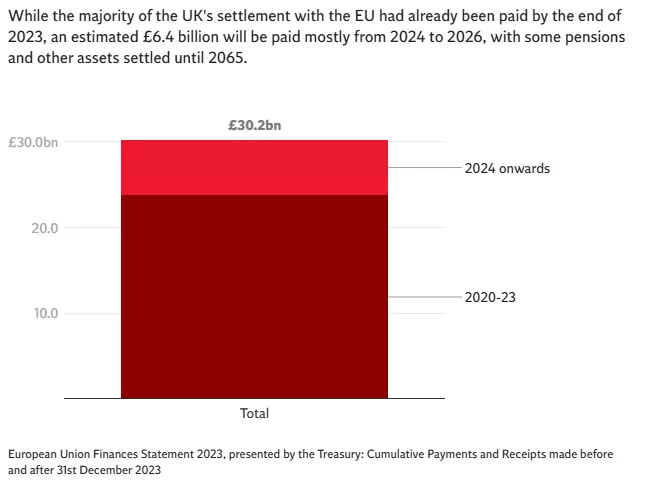
However, this cost is hardly comparable to the forecasted losses from exiting the EU in terms of GDP and trade.
A government spokesperson said: "It is important that we look forward, not backwards, that we do not reopen the Brexit divides, and that we make Brexit work for the British people.
"That is why we are resetting the relationship with our European friends to strengthen ties, secure a broad-based security pact and tackle barriers to trade."
But trade expert Mr Henig told The Independent that Brexit is not yet behind us: "I'm afraid the story of Brexit carries on. The issues aren't going away. We can't leave it all in the past."
So, what is the real cost of Brexit so far?
Britain's exit from the EU coincided with the outbreak of the coronavirus pandemic and lockdowns, from March 2020, which impacted economies globally.
IEA economist Mr Jessop said that it is still too soon to judge the long-term costs or benefits of Brexit, adding: "At the aggregate level, it is impossible to separate out the impact of Brexit from other shocks, notably the pandemic and the energy crisis. For what it is worth, my own guess is that the UK economy is now about one per cent smaller than it would otherwise have been."
Even so, the UK's GDP took the worst hit compared to all other G7 nations at the time; a 10.3 per cent drop in 2020.
UK suffered worst hit to GDP from Brexit-Covid double whammy
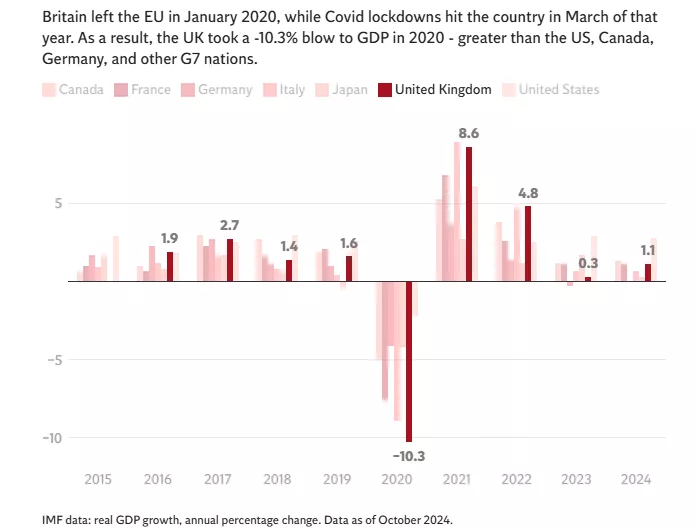
In 2023, Bloomberg Economics estimated that the UK is suffering £100bn a year in lost output from leaving the EU.
The economists Ana Andrade and Dan Hanson wrote that the UK committed "an act of economic self-harm when it voted to leave the EU", with GDP four per cent smaller than it would have been without Brexit.
In its latest forecasts alongside the new 2024 Budget, the Office for Budget Responsibility (OBR) estimated that UK trade will take a 15 per cent hit in the long term as a result of Brexit.
The independent financial watchdog pointed to "weak growth in imports and exports over the medium term [which] partly reflects the continuing impact of Brexit".
Sir Nick Harvey, the CEO of pro-EU think tank European Movement UK, is calling for a closer partnership with Europe to repair some of the economic damage from Brexit.
"Being out of the European single market has now dented the British economy by more than 5 per cent, causing an annual shortfall in Treasury finances of almost £45bn. That equates to around a third of the basic rate income tax yield," he told The Independent.
"Our future prosperity and security demand a much closer partnership with Europe. The government's 'reset' points in the right direction, but they need to go much further and much faster if we are to build a brighter future."
The impact on trade
A recent study from the Centre for Economic Performance at LSE found that goods exports from the UK dropped by £27bn in 2022 alone as a result of Brexit.
Specifically, the study concludes that the UK's trade cooperation agreement (TCA), implemented in January 2021, reduced UK goods exports (excluding services) worldwide by 6.4 per cent due to a 13.2 per cent fall in EU exports.
The paper's authors said that the drop in EU trade post-Brexit was due to the "introduction of new trade barriers under the TCA, rather than the uncertainty of the withdrawal process".
The study suggests that 16,400 businesses - some 14 per cent of UK exporters - stopped exporting to the EU due to Brexit trade rules.
Though Thomas Sampson, co-author and LSE economics professor, says that the hit to trade was "less than expected", he also called the TCA a "disaster for small exporters".
UK goods import-export gap has widened post-Brexit
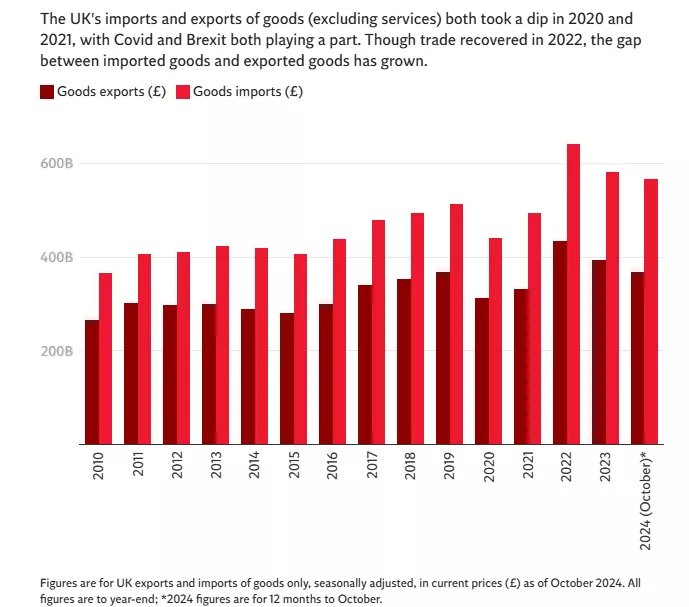
Part of this is likely due to the increased complexity of new export regulations, which larger businesses are better equipped to absorb. Marks & Spencer's chair has said that the retailer has had to rent a warehouse just to store paperwork.
Mr Henig, director of the UK Trade Policy Project, said that figures show Britain has suffered more than the EU from the loss in trade.
"Brexit has negatively affected our exports, more than our imports from the EU. It's been easier for European importers to find alternate suppliers, than for UK importers to replace European suppliers."
Some of the worst-hit trade sectors have been food, agriculture and fishing.
Overall, food exports to the EU have taken an average hit of £2.8bn each year since the end of the transition period, according to the Centre for Inclusive Trade Policy (CITP).
This 16 per cent average drop in food and agricultural exports shows "no recent signs of regaining previous levels", according to the CITP report, and is impacted by burdensome border checks and administrative processes.
On the production side, farmers no longer benefit from the EU's common agricultural policy, a substantial loss considering the UK's own cuts to farming subsidies.
The Lib Dems have estimated farming subsidies have fallen by 20 per cent in real terms since 2015 and the industry has struggled with recruiting workers to fill shortages.
Within the dairy business, one in 12 farmers has had to cut production in 2024, according to a poll from Arla Foods UK, with 56 per cent of dairy producers saying it is harder to recruit workers post-Brexit and Covid.
Consumers are feeling the blowback from these pressures, too. High inflation on food and non-alcoholic beverages would have been 8 per cent lower in the absence of Brexit, according to a separate LSE study from 2023.
The paper's authors say that there is "strong evidence that Brexit is the driving force behind these effects", separate to pressures from Covid and the Ukraine war.
As part of its anti-EU campaign, Nigel Farage's Ukip party launched a poster series in 2015 suggesting that UK fishing had been "ripped apart" by the EU.
Yet fishermen have been largely unhappy with post-Brexit terms agreed in the TCA, with a French-British stalemate and continued restrictions on British fishing.
UK's seafood exports down by 26% since Brexit
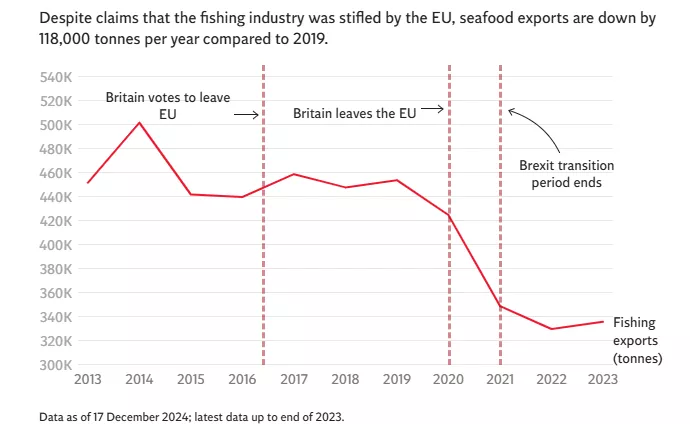
Seafood exports have dropped by a quarter since 2019, from 454,000 tonnes a year to 336,000 tonnes in 2023. This represents a monetary drop of £283m, according to the UK's latest trade statistics.
In December, Sir Keir struck a new EU fishing deal worth £360m, which will increase fishing opportunities by 15,000 tonnes (11 per cent).
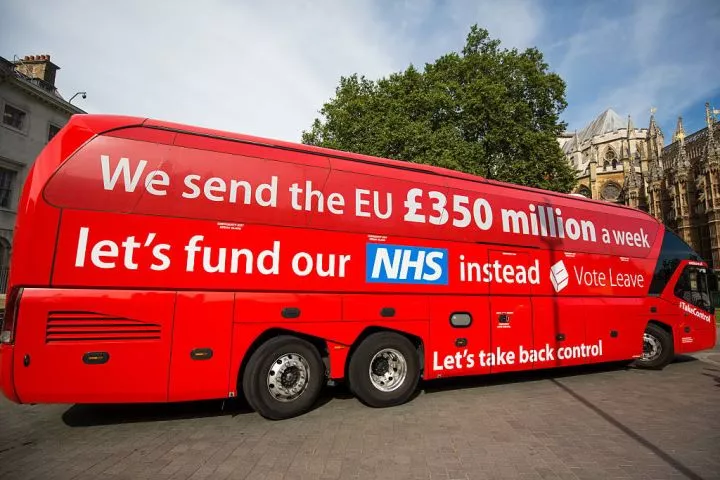
One argument for Vote Leave, famously featured on posters and a "Brexit bus", asserted that Britain sent £350m a week to the EU, which could be better spent on the NHS instead.
It is difficult to say whether this cash-value sum, which would amount to approximately £18.2bn a year, has been diverted into the NHS.
When excluding emergency funding due to Covid, the planned NHS budget scarcely increased in 2020/21 and 2021/22.
However, from fiscal year 2022/23, the core NHS budget jumped from £162.3bn to £185.4bn.
Department of Health and Social Care spending
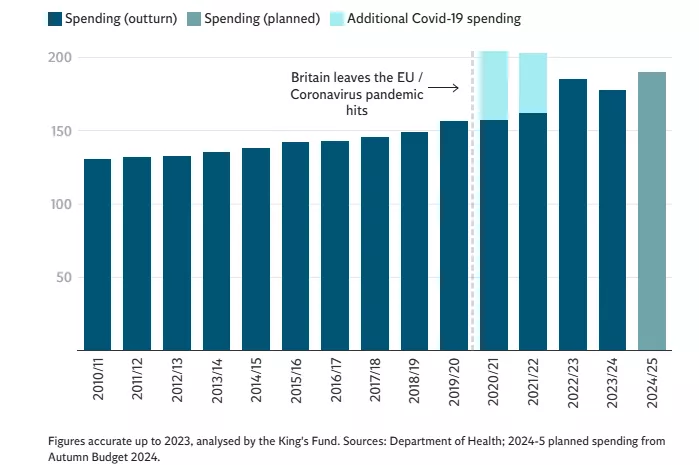
This budget was still lower than the previous year when including additional Covid spending.
In 2023, Vote Leave campaigner Michael Gove claimed that Brexit had "delivered" on its £350m NHS pledge, though no evidence was provided.
Given the overlap of Covid and Brexit, it is very difficult to say whether money saved from leaving the EU was spent on the NHS, and what incentives were used to make funding decisions.
Following the 2016 referendum, Mr Farage immediately said he was unable to promise money paid to the EU would instead be spent on the NHS, saying: "No I can't [guarantee it], and I would never have made that claim. That was one of the mistakes that I think the Leave campaign made."
Migration: failed promises
A key principle of the Leave campaign was to cut down on immigration. In an open letter to Mr Cameron in the Sunday Times in 2016, Boris Johnson and Mr Gove wrote: "The promise [of curbing net migration] is plainly not achievable as long as the UK is a member of the EU and the failure to keep it is corrosive of public trust in politics."
But leaving the EU did not have the intended effect on net migration.
Though Britain left the EU in 2020, free movement was in place until January 2021. Since then, net migration and immigration have soared.
At least 3.6 million immigrants have entered the UK since Brexit (between June 2021 and June 2024, the latest available data); with net migration at 2.3 million over that period.
Immigration is far from reaching pre-Brexit levels
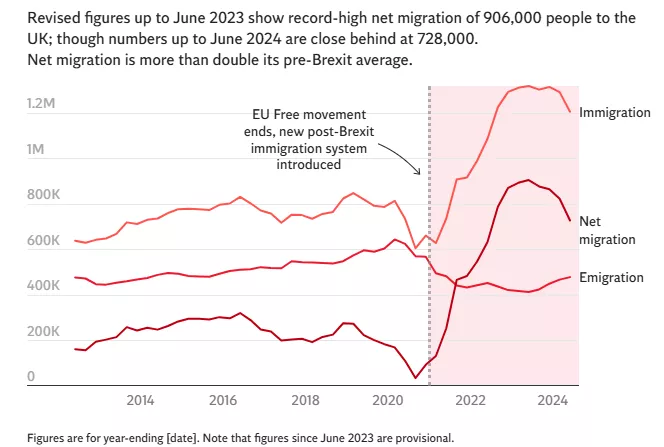
Within the first 12 months of Brexit immigration rules (up to December 2021), net migration jumped to 484,000; higher than any level in the past decade.
This trajectory has largely increased; revised government figures for the year ending June 2023 show record-breaking levels of net migration at 906,000 people.
In the four years before Brexit, net migration was higher from EU countries than non-EU countries.
Since 2019, data shows that the majority of net migration to the UK comes from non-EU countries; with figures at 662,000 in 2023 alone.
In fact, since 2021 when Brexit rules came into effect, net migration from the EU has been negative; meaning that more EU nationals are leaving the UK than coming to stay.
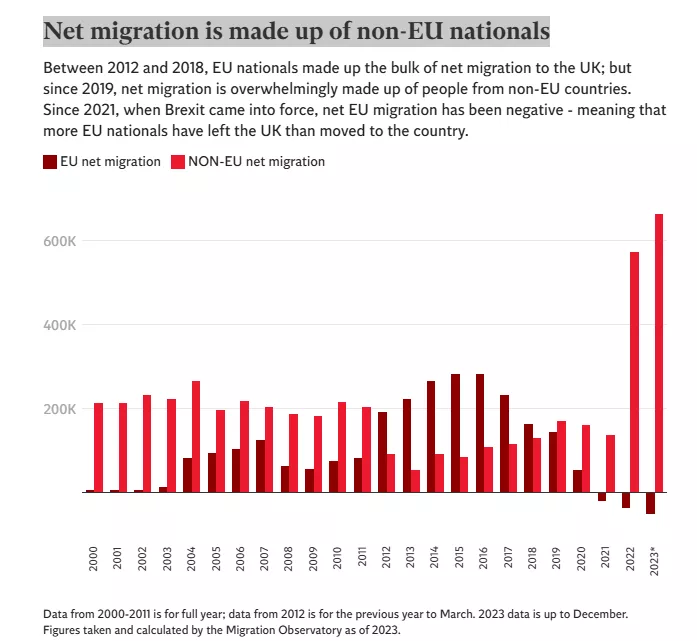
Between the Brexit referendum in 2016 and the end of free movement in 2021, approximately 1,227,800 EU nationals emigrated from the UK. This was up by 58 per cent from the previous five-year period, according to analysis of figures from the Migration Observatory.
IEA economist Mr Jessop asserted that "some workers have benefited from higher wages as the UK becomes less dependent on cheaper migrant labour from the EU".
Brexit arguably had the intended effect of curbing EU migration. But the broader migration picture has simultaneously ballooned.
The top countries for non-EU immigration are India, Nigeria, Pakistan, China and Zimbabwe, according to the latest ONS figures.
As a result of Brexit, UK nationals also lost free movement to and within the EU.
The number of EU-nationality students in UK universities dropped from around 147,920 to 95,505 between 2019 and 2022, according to the Higher Education Statistics Agency.
Students from the EU previously paid home rates for higher education, at around £9,000. Now, all international students (including EU) pay higher fees, which can amount to between £35,260 and £59,260 a year at some such as Oxford University.
There is no central figure for the number of British students enrolled in EU universities. However, British students can no longer enjoy EU member rates for tuition fees in these institutions, which are as little as free in some universities.
British sovereignty
Though there are several ways in which Brexit has not met expectations, leaving the EU has allowed for more flexibility in lawmaking.
Value added tax (VAT) rules are one key area where this has been utilised.
The EU has minimum VAT restrictions that apply across member states, with certain exemptions. When Britain was in the EU, it was not able to cut VAT on green technologies like heat pumps, for example; though the EU has since cut VAT rates on solar panels.
It would also not have been possible to cut the infamous "tampon tax" under EU membership - since then, the EU has followed suit by allowing member states to exempt VAT on sanitary products.
The recent controversial move by Labour to charge VAT on private school fees was also facilitated by Brexit, as the EU law designates education a VAT-exempt activity.
Pro-Brexit former Tory cabinet minister Jacob Rees-Mogg said the last five years had shown that "the EU is sinking rapidly into a regulatory mire which we are just about avoiding - no thanks to this government".
Labour MP Stella Creasy, the chair of the Labour Movement for Europe, said: "The public are not fools - they know Brexit benefits are rarer than hens' teeth. What they now need is realistic solutions to the problems it is causing like a youth mobility deal or rejoining the pan-European Mediterranean convention."
(The Independent)



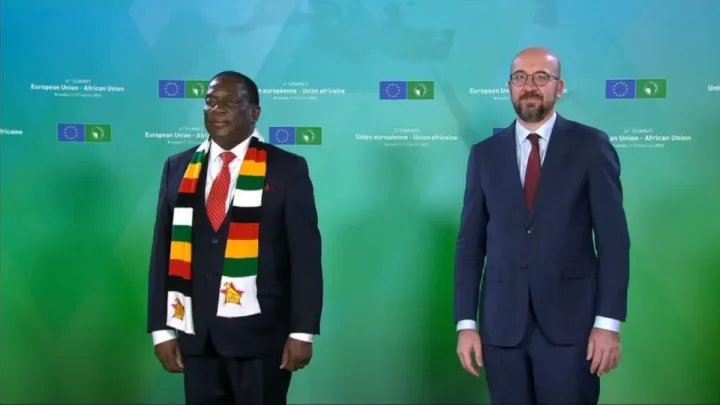
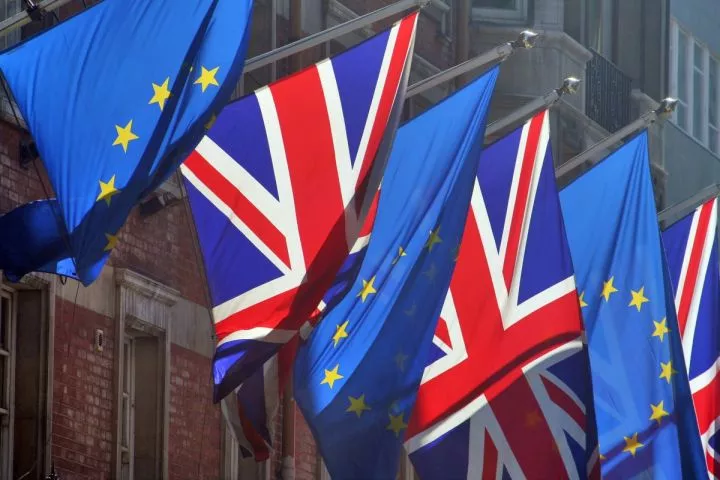











Comments